As an organizer, I always follow my client’s lead and only suggest we work on areas THEY identify. Every once in a while, though, I notice an irritating situation that could easily be solved with a label.
This scenario came up a month ago while working in someone’s dressing area: her space has a number of zones with specific task lighting tied to a central panel.
As we were leaving the space, she went to turn off her make-up area light. Not knowing which switch controlled which light, she ended up flicking every switch, one by one, until she found the ONE she needed. Her heavy sigh told me this issue is chronic.
So we fixed her problem — right then and there.
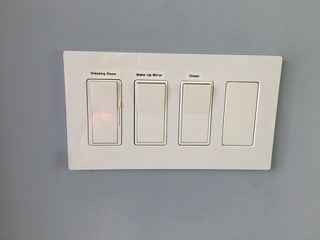
Now, if you know the story of the cobbler whose kids went barefoot, you will understand that just because I see “problem areas” in other people’s homes all day, this does not guarantee that I am a ruthless problem-solver in my own home.
Spoiler alert: not every shelf, bin or basket in my home is labeled!
Truth is, not every shelf, basket or bin NEEDS to be labeled. If it is obvious what it is and if no one is having an issue finding what they need, then there is no problem. But confusion breeds stress.
That same day, I went home and noticed myself doing the same thing to two of our three kitchen switches. That’s when I decided to do for myself what I do for others! So I labeled our switchplate. It’s been a game changer. The only thing I had to tweak was what I called them; my daughter did not think “door” made sense so we revised the label and now everyone is happy.
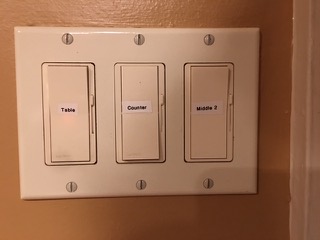
Our kitchen is the hub of our home, but now that the weather is warmer, we are spending a lot more time on our front porch.
Fast forward to the other day, when my husband texted me to make sure I turned off the front pathway lights. Our guests had stayed late the night before, and he didn’t want to waste electricity. In the daylight, I could not see if the lights were on or off… Couple that confusion with another multi-switch panel, and my stress level was rising. Without a partner to check the outdoor fixture’s bulb, it was more exercise than I expected so early in the morning. I figured it out on my own, turned the pathway lights off and did what any organized person would do: I labeled each switch.
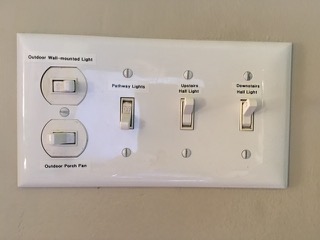
This time, my family approved of every label AND my daughter commented the next morning how helpful it was to know which switch controlled which hallway light. She had stayed up later than all — not unusual for teenagers — and knowing that we sleep with our door open at night to give our dog freedom, she didn’t want to wake us with a bright light at the top of the stairs.
My labels helped protect my investment of time, saved our daughter from waking us, and granted me an uninterrupted night’s sleep!
Think of where a label or two could help your household function a little better or brighter, or maybe even ensure a better night’s sleep for you.
Banish household confusion with a label or two; it’s illuminating!

First, let me confess: I am NOT what you might call an “Early Adopter” when it comes to technology.
I need to know that an app/program has been around a long time, is secure and is fast and easy to learn and use.
Here are 5 tech tools that meet those requirements. Use them daily to free up mental clutter, to run on time with appointments and projects, and to help you access information quickly.
You will enjoy the benefits of a calmer daily routine and the ability to access information speedily if you take a little effort to use one or more of these tech tools!

Next month I’m heading over to the UK for a two-week tour of England where I’ll be staying in a different accommodation almost every night. While super exciting, packing for such a trip can be a nightmare. I don’t need to lug my large suitcase containing everything for my 10 day trip into a hotel where I’m only staying one night. So what to do? Read on to learn how I’ve mastered the art of packing and the dreaded road trip packing!
Okay, so that deals with your regular packing needs. For a road trip where you’ll be staying in multiple hotels you’ll need one large suitcase and one overnight duffle or carry on size case.
If you’ve ever wondered, do organizers really practice what they preach?
I am here to say, YES! In my case, I follow 4 basic rules*:
1. Decide where things live
2. Return items to their “home”
3. Follow In One/Out One
4. Build routines around maintaining systems
 The third rule, In One/Out One, is the least appreciated and most neglected by our clients, even though it offers the best defense against clutter build-up.
The third rule, In One/Out One, is the least appreciated and most neglected by our clients, even though it offers the best defense against clutter build-up.
Here’s a personal story of how it recently went down in my house.
First you have to know that I LOVE citrus. Fresh lemon juice goes into every salad dressing. Fresh lime juice refreshes most fruit bowls. Many of my fish recipes require fresh lemon, lime or orange juice. So my juicer has been a staple in my kitchen. I love that it not only does a great job, it also attaches to a measuring cup – which makes it easy to know when I have enough.
Pictured below on the left, it had a primo spot in my most accessible gadget drawer just below my prep counter. Until…
 My husband, an aspiring minimalist, bought me a new juicer. He had researched to get me “the perfect gift.” I was skeptical, even though for him to buy something it MUST be great. I could not imagine HOW anything could replace my beloved juicer.
My husband, an aspiring minimalist, bought me a new juicer. He had researched to get me “the perfect gift.” I was skeptical, even though for him to buy something it MUST be great. I could not imagine HOW anything could replace my beloved juicer.
It would have to at least be:
• super easy to use
• simpler to clean
Well, my new citrus press is all that AND bold and bright. In being so colorful — I smile every time I see it.
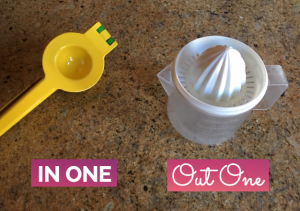 But it took me some time to let go of my trusted fave…2 weeks, in fact. I call it the testing time. Some “old” items deserve this reflective time.
But it took me some time to let go of my trusted fave…2 weeks, in fact. I call it the testing time. Some “old” items deserve this reflective time.
Honestly, it took me a week to open the package and try the new “citrus press.” I felt like I was cheating on my trusted go-to.
Once, I tried it, I set an alarm on my calendar to remind me to “consider if keeping new juicer” and a few days later “decide if still need old juicer.”
When you replace something, even if you are committed to In One Out One, you don’t HAVE to let go immediately. But you must put a time limit on making your decision. (It’s too easy for items to stagnate, clog your drawers and attract more clutter.)
Since I was using these gadgets daily, it didn’t take long to know I was in love. As for my “old” juicer, it still has life left in it. My son is a decent cook at college — so guess who just inherited a new fave? 🙂 When he graduates, I will gift him his very own citrus press!
* Remember I said these were 4 rules that I think every Professional Organizer follows?
It’s true of any organized person.
• You don’t have to be a professional organizer to be organized.
• Some people are MORE organized than their organizer (GASP!)
Yes…it’s true. Not every organizer is the MOST organized person you’ll ever meet.
• Professional Organizers know how to help YOU solve your organizational overwhelms and clutter-crisis.
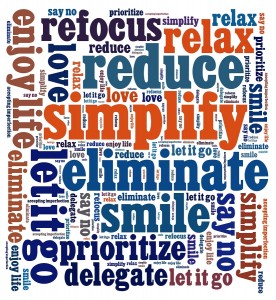
My birthday is Ground Hog’s Eve (Feb 1st). That means I get a do-over for whatever New Year’s Resolutions I haven’t followed through with. I get to make new resolutions for what I want to change before my next birthday. But this year I decided not to make resolutions. I decided to set intentions instead.
Resolutions too often include words like “don’t, won’t or never.” Intentions are focused on the future and can be stated in the present tense every day. After my morning meditation, I frequently set an intention to be grounded and focused throughout my day.
Intentions can become habits. A habit is defined as “an addictive behavior that is hard to give up” but an addiction does not need to be viewed negatively. For example, I am addicted to my grandchildren. The more time I spend with them the more time I want to spend with them.
What would happen if I became addicted to new habits? To become addicted, the first thing I need to do is to explore how I will benefit from my new habit. In sales, we are taught that when we convey the benefit first, ask key questions that lead our prospect to reply “yes” or to nod their head affirmatively, the close will take care of itself.
In December I set an intention to allow more time to get places and not squeeze one more thing in before getting out the door. Then I decided I couldn’t wait until January to put this into action because rushing to get out the door was stressing me out and negatively affecting everyone around me.
It isn’t an intention anymore; it’s a new habit. The benefit of allowing myself more time to get places and get out the door on time is that I don’t feel stressed about forgetting something important or anxious about being late. I am more grounded and focused throughout my day.
Habits create different types of energy. Good habits create positive energy that flows. “Bad” habits create problems like clutter and disorganization; a stagnation of energy, productivity and efficiency.
As a Home Organizer I look for the cause of the clutter and chaos in a space and often I see it is because of “bad” habits like not processing junk mail or not breaking down cardboard boxes when they are empty. When I am finished with a client, I make recommendations to help them to create new habits that will keep the clutter from re-accumulating and will maintain the serenity that organization has created.
One of the biggest challenges in life is to walk your walk and talk your talk. I intend to do that starting now and not wait until New Year’s Eve or Ground Hog’s Eve.

I am a parent of two older teens, one in the first year of college and one in the later years of high school. As an organizer, my kids grew up with structure and routine, in hopes of them learning to be organized as adults. Our home was organized, our mornings ran fairly smoothly, and homework was completed without any issues. There were a few sticky points, such as screen time and bed time, but for the most part, our daily lives ran smoothly overall.
Now that they are older, the organizer mom in me still wants to help them be the most efficient they can be. But the cognitive side of my brain knows that now is the time to let go, and let them make their own decisions. I should only help them when they ask me for it. However, it is very difficult for me to sit back and watch them make mistakes such as scheduling two events for the same time, or running late for something. But I know the only way they will learn is by my stepping back and giving them the control to manage their own time, schedules, and things. They will make mistakes, and learn from them.
As hard as this is for me to let things go, I am getting better at it. I still sometimes find myself jumping in when I shouldn’t, and they both let me know when I am intervening where I shouldn’t be. I just take note of this, and try to not make that mistake again in the future.
I am sure I am not alone, being a parent during this transitional time. I wish all of you the inner strength and patience to step back, and let your teens develop into the wonderful young adults we all want them to be!